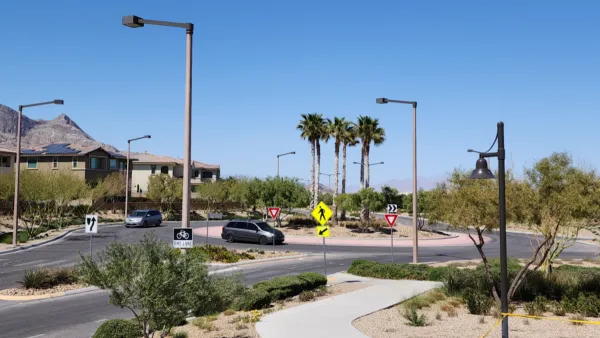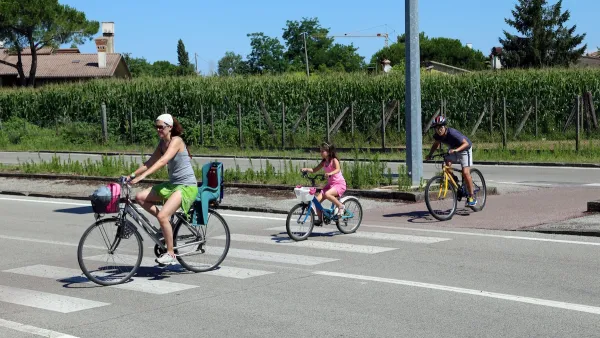Alexandria Abramian Mott spotlights several grassroots ways -- from signs to screams -- in which "fed-up residents are reclaiming their streets, or at least trying to."
Is it time to bid adieu to the much derided speed hump? Mott profiles the efforts of several Southern Californians who have taken traffic-calming into their own hands with creative and innovative solutions.
One project highlighted is the road mural painted by Joe Linton, artist and organizer for the L.A. walking and biking event CicLAvia, and his fellow neighbors in the Koreatown section of Los Angeles. "'I think it really works to slow cars down,' Linden said of the mural at the T intersection of Bimini Place and White House Place. He said the artwork helps to take drivers out of their typical 'just-have-to-get-to-their-destination' frame of mind and makes them realize that 'streets are public spaces where people can really interact.'"
Another, perhaps less successful but more prevalent, practice profiled is screaming, as demonstrated by "vigilante Eric Lapidus," who "routinely shouts at drivers flying down his tree-lined Spaulding Square avenue."
The result? "'Sometimes people do slow down,' Lapidus said. But is the occasional victory worth the vocal cord strain? 'Hardly,' Lapidus said. 'But it helps relieve the anger I feel when I see people blasting down our street when kids are playing ball just a few feet from them.'"
FULL STORY: DIY speed bumps: Traffic control for neighborhoods

National Parks Layoffs Will Cause Communities to Lose Billions
Thousands of essential park workers were laid off this week, just before the busy spring break season.

Retro-silient?: America’s First “Eco-burb,” The Woodlands Turns 50
A master-planned community north of Houston offers lessons on green infrastructure and resilient design, but falls short of its founder’s lofty affordability and walkability goals.

Delivering for America Plan Will Downgrade Mail Service in at Least 49.5 Percent of Zip Codes
Republican and Democrat lawmakers criticize the plan for its disproportionate negative impact on rural communities.

Test News Post 1
This is a summary

Test News Headline 46
Test for the image on the front page.

Balancing Bombs and Butterflies: How the National Guard Protects a Rare Species
The National Guard at Fort Indiantown Gap uses GIS technology and land management strategies to balance military training with conservation efforts, ensuring the survival of the rare eastern regal fritillary butterfly.
Urban Design for Planners 1: Software Tools
This six-course series explores essential urban design concepts using open source software and equips planners with the tools they need to participate fully in the urban design process.
Planning for Universal Design
Learn the tools for implementing Universal Design in planning regulations.
EMC Planning Group, Inc.
Planetizen
Planetizen
Mpact (formerly Rail~Volution)
Great Falls Development Authority, Inc.
HUDs Office of Policy Development and Research
NYU Wagner Graduate School of Public Service




























